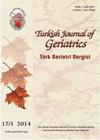IMMUNOGLOBULIN G4-RELATED DISEASE PRESENTING AS URETERAL MALIGNANCY AND URETERAL STRICTURE TREATED WITH AZATHIOPRINE AFTER SURGERY IN A GERIATRIC PATIENT WITH A SINGLE FUNCTIONAL KIDNEY: A CASE REPORT
IF 0.3
4区 医学
Q4 GERIATRICS & GERONTOLOGY
Turkish Journal of Geriatrics-Turk Geriatri Dergisi
Pub Date : 2020-06-01
DOI:10.31086/tjgeri.2020.163
引用次数: 0
Abstract
Immunoglobulin G4-related sclerosing ureteral disease is a rare benign disorder characterised by fibrosis and lymphoplasmacytic infiltration in the ureter. A 70-year-old man with a single functional kidney and left flank pain was diagnosed with IgG4-related ureteral disease that presented as a unilateral ureteral mass. Left hydronephrosis and a 25 × 23 × 26 mm left midureteral mass were found. No malignancy was found on ureteroscopy and urinary cytology did not reveal any neoplastic cells. A 2 cm midureteral stenosis was found in the left ureter on retrograde pyelography. It was not a ureteral stricture but was the result of periureteral inflammation and fibrosis caused by immunoglobulin G4-related sclerosing disease. Initial endoscopic ablation-obliteration therapy was unsuccessful, and after 6 weeks the patient was treated by robotic ureteroureterostomy. Most plasma cells in the excised ureteral segment were IgG4-positive. Serum IgG4 was 273 mg/dL (normal range: 85–120 mg/dL). The histology of the ureteral segment resembled retroperitoneal fibrosis and the histopathology of the stricture included IgG4-positive cells, fibrosis and ureteritis. The patient was treated with oral azathioprine for 6 months. No evidence of recurrence was seen on ureteroscopy or abdominopelvic computed tomography at the 3-month or 1-year follow-up.免疫球蛋白g4相关疾病表现为输尿管恶性肿瘤和输尿管狭窄,手术后用硫唑嘌呤治疗1例老年单肾功能患者
免疫球蛋白g4相关的硬化性输尿管疾病是一种罕见的良性疾病,以输尿管纤维化和淋巴浆细胞浸润为特征。一名70岁男性,单肾功能正常,左侧疼痛,诊断为igg4相关输尿管疾病,表现为单侧输尿管肿块。左侧肾积水,左侧输尿管肿块25 × 23 × 26 mm。输尿管镜检查未见恶性肿瘤,尿细胞学检查未见肿瘤细胞。逆行肾盂造影发现左侧输尿管狭窄2 cm。它不是输尿管狭窄,而是由免疫球蛋白g4相关硬化疾病引起的输尿管周围炎症和纤维化的结果。最初的内镜消融-闭塞治疗不成功,6周后患者接受机器人输尿管输尿管造口术治疗。输尿管切除段大部分浆细胞igg4阳性。血清IgG4为273 mg/dL(正常范围:85 ~ 120 mg/dL)。输尿管段组织学与腹膜后纤维化相似,狭窄组织病理表现为igg4阳性细胞、纤维化及输尿管炎。患者口服硫唑嘌呤治疗6个月。在3个月或1年的随访中,输尿管镜检查或腹腔计算机断层扫描均未发现复发的证据。
本文章由计算机程序翻译,如有差异,请以英文原文为准。
求助全文
约1分钟内获得全文
求助全文
来源期刊

Turkish Journal of Geriatrics-Turk Geriatri Dergisi
GERIATRICS & GERONTOLOGY-
CiteScore
0.60
自引率
0.00%
发文量
46
审稿时长
6-12 weeks
期刊介绍:
Turkish Journal of Geriatrics is a peer-reviewed journal. Official language of the journal is English. Turkish Journal of Geriatrics invites submission of Original Articles based on clinical and laboratory studies. Review Articles are published only after the invitation from the Editorial Board.
 求助内容:
求助内容: 应助结果提醒方式:
应助结果提醒方式:


